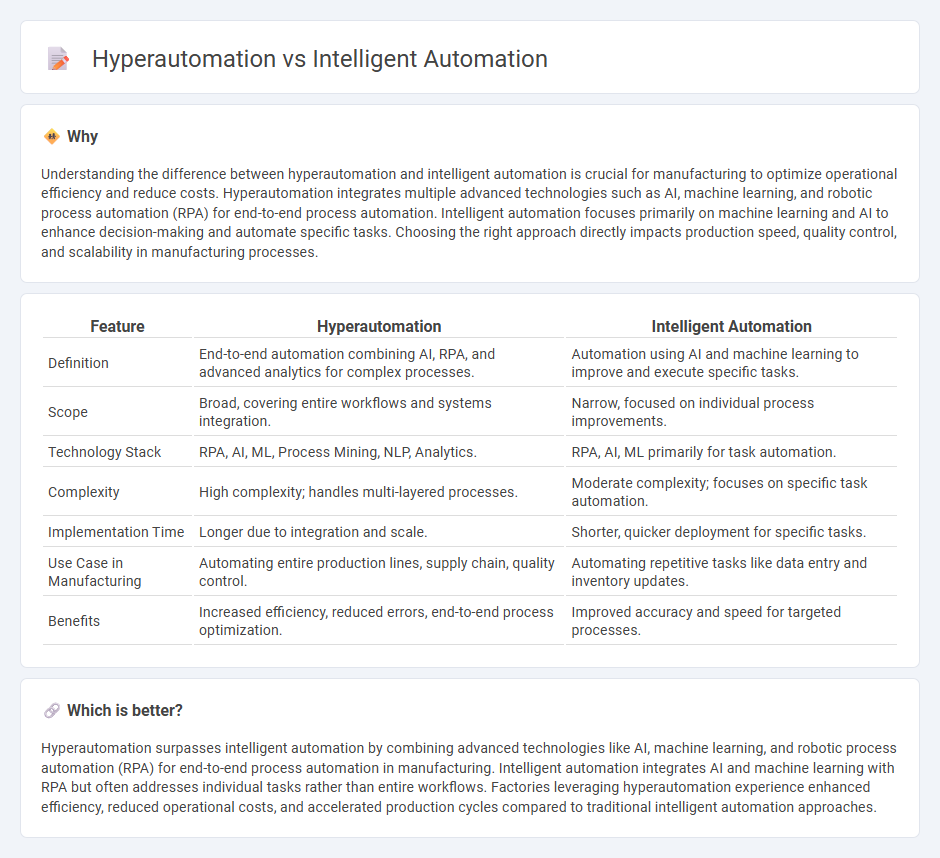
Hyperautomation integrates advanced technologies such as artificial intelligence, machine learning, and robotic process automation to optimize and scale manufacturing processes beyond traditional automation limits. Intelligent automation focuses on automating complex tasks by leveraging cognitive technologies that enable real-time decision-making and adaptability in manufacturing environments. Explore in-depth insights on how hyperautomation and intelligent automation are transforming the future of manufacturing.
Why it is important
Understanding the difference between hyperautomation and intelligent automation is crucial for manufacturing to optimize operational efficiency and reduce costs. Hyperautomation integrates multiple advanced technologies such as AI, machine learning, and robotic process automation (RPA) for end-to-end process automation. Intelligent automation focuses primarily on machine learning and AI to enhance decision-making and automate specific tasks. Choosing the right approach directly impacts production speed, quality control, and scalability in manufacturing processes.
Comparison Table
| Feature | Hyperautomation | Intelligent Automation |
|---|---|---|
| Definition | End-to-end automation combining AI, RPA, and advanced analytics for complex processes. | Automation using AI and machine learning to improve and execute specific tasks. |
| Scope | Broad, covering entire workflows and systems integration. | Narrow, focused on individual process improvements. |
| Technology Stack | RPA, AI, ML, Process Mining, NLP, Analytics. | RPA, AI, ML primarily for task automation. |
| Complexity | High complexity; handles multi-layered processes. | Moderate complexity; focuses on specific task automation. |
| Implementation Time | Longer due to integration and scale. | Shorter, quicker deployment for specific tasks. |
| Use Case in Manufacturing | Automating entire production lines, supply chain, quality control. | Automating repetitive tasks like data entry and inventory updates. |
| Benefits | Increased efficiency, reduced errors, end-to-end process optimization. | Improved accuracy and speed for targeted processes. |
Which is better?
Hyperautomation surpasses intelligent automation by combining advanced technologies like AI, machine learning, and robotic process automation (RPA) for end-to-end process automation in manufacturing. Intelligent automation integrates AI and machine learning with RPA but often addresses individual tasks rather than entire workflows. Factories leveraging hyperautomation experience enhanced efficiency, reduced operational costs, and accelerated production cycles compared to traditional intelligent automation approaches.
Connection
Hyperautomation integrates intelligent automation technologies such as AI, machine learning, and robotic process automation (RPA) to streamline complex manufacturing workflows, enhancing operational efficiency and reducing human error. Intelligent automation applies cognitive capabilities to analyze data and make real-time decisions on production lines, while hyperautomation combines multiple automation tools to scale these processes across entire manufacturing systems. By leveraging interconnected intelligent automation components, hyperautomation drives comprehensive digital transformation in manufacturing, boosting productivity and innovation.
Key Terms
Artificial Intelligence (AI)
Intelligent automation leverages AI to perform specific repetitive tasks, enhancing efficiency through machine learning and natural language processing. Hyperautomation expands this by integrating multiple AI-driven tools and technologies, orchestrating complex workflows for end-to-end business process automation. Explore more to understand how AI transforms automation strategies for competitive advantage.
Robotic Process Automation (RPA)
Intelligent automation integrates Robotic Process Automation (RPA) with artificial intelligence (AI) to enhance decision-making and automate complex processes beyond simple rule-based tasks. Hyperautomation expands on this by combining multiple tools including RPA, AI, machine learning, and process mining to create an end-to-end automation pipeline that continuously improves and adapts. Explore the detailed differences and benefits of RPA within intelligent automation and hyperautomation to optimize your business operations.
Process Orchestration
Process orchestration in intelligent automation involves coordinating discrete tasks using rule-based systems to improve efficiency, while hyperautomation leverages AI, machine learning, and advanced analytics to autonomously manage and optimize complex workflows across multiple platforms. Intelligent automation typically handles individual processes, whereas hyperautomation integrates diverse technologies to enable end-to-end automation and continuous improvement. Discover how process orchestration evolves in hyperautomation to transform business operations.
Source and External Links
What is Intelligent Automation? | IBM - Intelligent automation combines AI, robotic process automation (RPA), and business process management (BPM) to automate repetitive tasks and scale decision-making, improving operational efficiencies and transforming workflows across industries.
What is Intelligent Automation? | Oracle - Intelligent automation integrates AI, RPA, machine learning, natural language processing, and integration technologies to execute complex business processes, augment human decision-making, and enhance accuracy and efficiency.
What is Intelligent Automation? | AWS - Intelligent automation uses AI technologies such as machine learning and natural language processing to create self-improving software automations that learn from data and adapt workflows dynamically without human intervention.
 dowidth.com
dowidth.com